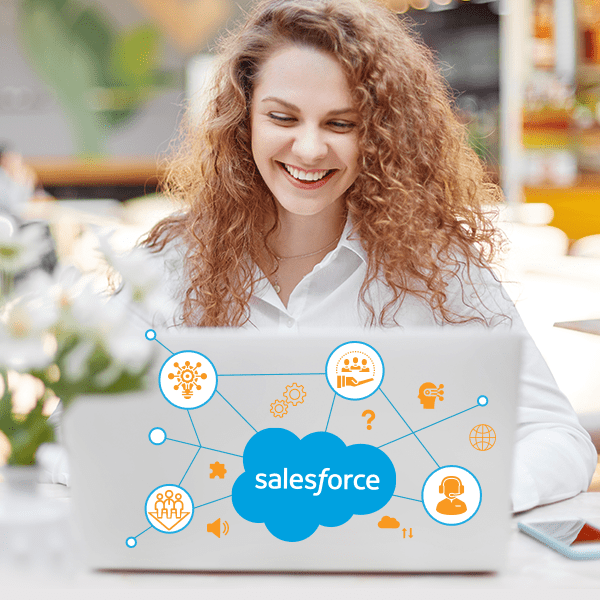Salesforce plays a crucial role for organizations with an integrated Learning Management System (LMS). While an LMS delivers integrated customer training, staff training, and member training within its framework, it enhances learner data reporting capabilities and advanced analytics. This integration allows organizations to synchronize information for better control over sales pipelines, employee training progress tracking, and more. An LMS is no longer restricted to just delivering online and offline learning for various stakeholders. Let’s explore how a customer-centric strategy built on its platform can benefit any organization.

Advantages of a Salesforce-Integrated LMS
Salesforce allows for meaningful, actionable insights from LMS learner data by creating a transparent data funnel with the help of sales, customer service, and marketing teams. From employee training to pre-hiring assessments, reporting, and analytics, it makes a significant difference for an integrated LMS. Customer activities can be tracked through its platform to improve customer experience, product knowledge, and customer support, starting from onboarding, and its trained sales reps prove to be great catalysts in accomplishing this goal.
Pro Tip: “Read about our Salesforce LMS Integration.”
Customer-Centric LMS-Salesforce Strategy
1. Client Service is the Focal Point
In today’s marketing world, where social media marketing and online reviews dominate, customer support has become the focal point of all marketing efforts. Salesforce helps harness the power of marketing data for brand loyalty through buyer communities using relevant social media activities aligned with customer needs. AI-powered insights from this CRM platform assist in eliminating issues before they become problems.
An integrated LMS can help service executives get trained in identifying cases and utilize case management tools to address customer issues promptly. With an inbuilt e-commerce module, organizations can create their own branding with branded mobile apps and sell white-labeled LMS to partners and affiliates. Creating a strong brand allows for delivering a consistent message to sales, marketing, and customer or client support activities, ensuring customer loyalty and advocacy.
2. Seamless Customer Experience – Anywhere, Anytime, and on Any Device
Customer experience drives today’s businesses, and a single negative feedback online can bring a swarm of complaints and anguish against any brand. Salesforce integration ensures that technology delivers the most loved experience to consumers across devices and time zones as they desire.
Its integration with an LMS brings anywhere, anytime, and on-any-device learning experiences for customers and employees alike, whether it’s product knowledge or policy/compliance updates. This integration allows flexible campaign creation, a better purchase experience, and understanding the customer interaction patterns and preferred channels of communication for delivering seamless customer experiences.
3. Define Deliverable Realistic Expectations
Salesforce-LMS integration delivers better collaboration with customers through multiple collaborative tools and social media, including discussion forums, chats, messages, Q&As, polls, surveys, quizzes, and more. An effective customer retention strategy helps organizations deliver realistic results by utilizing resources efficiently.
Technologies like AI help LMSs align with client requirements and organizational capabilities while delivering the best learning solutions for a better customer experience. Its integration often leads to better collaboration and client satisfaction, fostering open communication.
4. Explore Client Data
By integrating LMS and Salesforce, organizations can explore the wealth of data they possess. AI tools help them leverage the power of learner and customer data to deliver the best-in-industry experiences in terms of customer engagement and learner experience, gathering data to extract actionable insights for the future.
It ensures building a strong brand value for the organization with targeted campaigns, better retention using the right channels, and more. Apart from that, the LMS can track learners’ progress, customer and learner interests, and suggest products, services, and training courses in the long run.
5. App-Based Experience Building
An integrated LMS helps organizations track every move of the customer’s journey through an advanced app. Customers might use the app for consuming content, making purchases, learning online, or on-demand (even without a network).
Gamified methods to deliver a fun-filled learning experience by earning badges, leaderboards, certifications, accreditations, and more using the mobile app transform learning and purchase experience, all due to Salesforce and LMS integration.
Leveraging Emerging Technologies
In 2025, organizations can further enhance their Salesforce LMS strategy by incorporating emerging technologies like:
- Artificial Intelligence (AI): AI-powered chatbots can provide personalized support to customers, while AI-driven analytics can help organizations predict customer behavior and preferences.
- Virtual and Augmented Reality (VR/AR): VR/AR can be used to create immersive learning experiences for customers and employees, enhancing engagement and retention.
- Internet of Things (IoT): IoT devices can provide valuable data on customer behavior and preferences, which can be integrated with it to deliver personalized experiences.
Conclusion
Salesforce can enhance commerce, sales, and marketing efficiency while creating the best client service experience to ensure customer retention and continuous learning for all stakeholders (learners, including staff, customers, partners, vendors, etc.). Moreover, its integration with LMS also allows synchronization with HRMS, AMS, and other third-party applications by synchronizing data into the LMS whenever a new user is registered with it or another system. To learn more about our integrated LMS capabilities, connect with our industry experts now!
Demo
Tags

